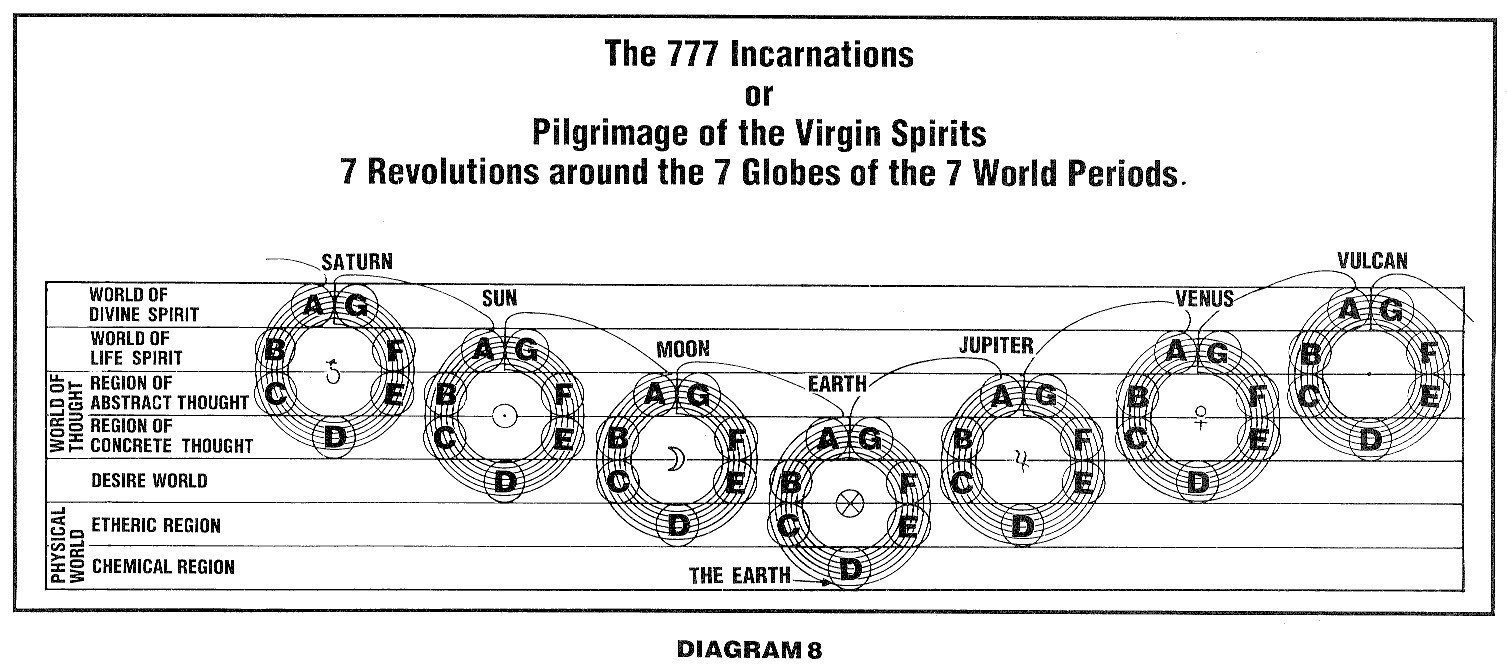
| rosicrucianU.com | ||
| Simplified Scientific Christianity |

They all recline beneath the tree, and Gurnemanz begins: "On the night when our Lord and Saviour, Christ Jesus, ate the Last Supper with his disciples He drank the wine from a certain chalice, and that was later used by Joseph of Arimathea to catch the lifeblood which flowed from the wound in the Redeemer's side. He also kept the bloody lance wherewith the wound was inflicted, and carried these relics with him through many perils and persecutions. At last they were taken in charge by Angels, who guarded them until one night a mystic messenger sent from God appeared and bade Titurel, Amfortas' father, build a castle for the reception and safe-keeping of these relics. Thus the Castle of Mount Salvat was built on the high mountain, and the relics lodged there under the guardianship of Titurel with a band of holy and chaste knights whom he had drawn around him. It became a center whence mighty spiritual influences went forth to the outside world.
"But there lived in yonder heathen vale a black knight who was not chaste, yet desired to become a Knight of the Grail, and to that end he mutilated himself. He deprived himself of the ability to gratify his passion, but the passion remained. King Titurel saw his heart filled with black desire, and refused him admittance. Klingsor then swore that if he could not serve the Grail, the Grail should serve him. He built a castle with a magic garden and populated it with maidens of ravishing beauty, who emitted an odor like flowers, and these waylaid the Knights of the Grail (who must pass the castle when leaving or returning to Mount Salvat) ensnaring them to betray their trust and violate their vows of chastity. Thus they became the prisoners of Klingsor and but few remained as defenders of the Grail.
"In the meantime Titurel had turned the wardenship of the Grail over to his son Amfortas and the latter, seeing the serious havoc wrought by Klingsor, determined to go out to meet and to do battle with him. To that end he took with him the holy spear.
"The wily Klingsor did not meet Amfortas in person, but evoked Kundry and transformed her from the hideous creature who appeared as the servitor of the Grail to a woman of transcendent beauty. Under Klingsor's spell she met and tempted Amfortas, who yielded and sank into her arms, letting go his hold upon the sacred spear. Klingsor then appeared, grasped the spear, inflicted a wound upon the defenseless Amfortas, and but for the heroic efforts of Gurnemanz he would have carried Amfortas a prisoner to his magic castle. He has the holy spear, however, and the king is crippled with suffering, for the wound will not heal."
The young squires spring up, fired with ardor, vowing that they will conquer Klingsor and restore the spear. Gurnemanz sadly shakes his head, saying that the task is beyond them, but reiterates the prophecy that the redemption shall be accomplished by a "pure fool, by pity enlightened."
Now cries are heard: "The swan! Oh, the swan!" and a swan flutters across the stage and falls dead at the feet of Gurnemanz and the squires, who are much agitated at the sight. Other squires bring in a stalwart youth armed with bow and arrows, and to Gurnemanz's sad inquiry, "Why did you shoot the harmless creature?" he answers innocently, "Was it wrong?" Gurnemanz then tells him of the suffering king and of the swan's part in making the healing bath. Parsifal is deeply moved at the recital and breaks his bow.
In all religions the quickening spirit has been symbolically represented as a bird. At the Baptism, when Jesus' body was in the water the Spirit of Christ descended into it as a dove. "The Spirit moves upon the water," a fluidic medium, as the swans move upon the lake beneath the Yggdrasil, the tree of life of Norse mythology, or upon the waters of the lake in the legend of the Grail. The bird is therefore a direct representation of highest spiritual influence and well may the knights sorrow at the loss. Truth is many sided. There are at least seven valid interpretations to each myth, one for each world, and looked at from the material, literal side, the compassion engendered in Parsifal and the breaking of his bow mark a definite step in the higher life. No one can be truly compassionate and a helper in evolution while he kills to eat, either in person or by proxy. The harmless life is an absolute essential prerequisite to the helpful life.
Gurnemanz then commences to question him about himself: who he is, and how he came to Mount Salvat. Parsifal displays the most surprising ignorance. To all questions he answers, "I do not know." At last Kundry speaks up and says: "I can tell you who he is. His father was the noble Gamuret, a prince among men, who died fighting in Arabia while this child was yet in the womb of his mother, Lady Herzleide. With his last, dying breath his father named him Parsifal, the pure fool. Fearing that he would grow up to learn the art of war and be taken from her, his mother brought him up in a dense forest in ignorance of weapons and warfare."
Here Parsifal chimes in: "Yes, and one day I saw some men on shapely beasts; I wanted to be like them, so I followed them for many days till at last I came here and I had to fight many manlike monsters."
In this story we have an excellent picture of the soul's search for the realities of life. Gamuret and Parsifal are different phases of the life of the soul. Gamuret is the man of the world, but in time he became wedded to Herzleide, heart affliction, in other words. He meets sorrow and dies to the world, as all of us do who have come into the higher life. While the bark of life floats on summer seas and our existence seems one grand, sweet song there is no incentive to turn to the higher; every fibre in our bodies cries, "This is good enough for me," but when the billows of adversity roar around us and each succeeding wave threatens to engulf us, then we have wedded heart affliction and become men of sorrows, and are ready to be born as Parsifal, the pure fool or the soul who has forgotten the wisdom of the world and is seeking for the higher life. So long as a man is seeking to accumulate money or to have a good time, so miscalled, he is wise with the wisdom of the world; but when he sets his face toward the things of the Spirit, he becomes a fool in the eyes of the world. He forgets all about his past life and leaves his sorrows behind him, as Parsifal left Herzleide, and we are told that she died when Parsifal did not return to her. So sorrow dies when it has given birth to the aspiring soul that flees from the world; he may be in the world to perform his duty but is not of the world.
Gurnemanz has now become imbued with the idea that Parsifal is to be the deliverer of Amfortas and takes him along to the Grail Castle. And to Parsifal's question, "Who is the Grail?" he answers:
Here we find Wagner bringing us back into pre-Christian times, for before the advent of Christ, Initiation was not free to "whosoever will" seek in the proper manner, but was reserved for certain chosen ones such as the Brahmins and the Levites, who were given special privileges in return for being dedicated to the temple service. The coming of Christ, however, wrought certain definite changes in the constitution of mankind, so now all are capable of entering the pathway of Initiation.
(You are welcome to e-mail your answers and/or comments to us. Please be sure to include the course name and Independent Study Module number in your e-mail to us. Or, you are also welcome to use the answer form below.)
1. For what purpose was the Castle of Mount Salvat built?
2. Who was Klingsor?
3. What is the real significance of the swan?
4. What phases in the life of the soul do Parsifal, Gamuret, and Herzleide symbolize?
5. What gives birth to the aspiring soul?
6. Who does Gurnemanz think Parsifal is?
7. What is the significance of Gurnemanz's reply to Parsifal's question: "Who is the Grail?"

|

|

|
|
|
Contemporary Mystic Christianity |
|
|
This web page has been edited and/or excerpted from reference material, has been modified from its original version, and is in conformance with the web host's Members Terms & Conditions. This website is offered to the public by students of The Rosicrucian Teachings, and has no official affiliation with any organization. | Mobile Version | |
|